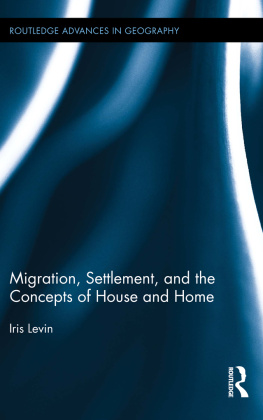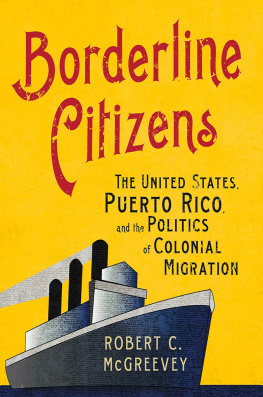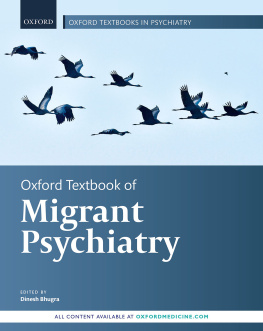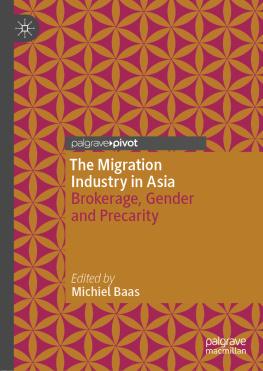Migration, Settlement, and the Concepts of House and Home
How do migrants feel at home in their houses? Literature on the migrant house and its role in the migrant experience of home-building is inadequate. This book offers a theoretical framework based on the notion of homebuilding and the concepts of home and house embedded within it. It presents innovative research on four groups of migrants who have settled in two metropolitan cities in two periods: migrants from Italy (migrated in the 1950s and 1960s) and from mainland China (migrated in the 1990s and 2000s) in Melbourne, Australia, and migrants from Morocco (migrated in the 1950s and 1960s) and from the former Soviet Union (migrated in the 1990s and 2000s) in Tel Aviv, Israel. The analysis draws on qualitative data gathered from forty-six in-depth interviews with migrants in their home-environments, including extensive visual data. Levin argues that the physical form of the house is meaningful in a range of diverse ways during the process of home-building, and that each migrant group constructs a distinct form of home-building in their homes/houses, according to their specific circumstances of migration, namely the origin country, country of destination, and period of migration, as well as the historical, economic, and social contexts around migration.
Iris Levin is a post-doctoral researcher who has recently completed a large research project at Flinders University and is about to commence a new project at Tel Aviv University.
Routledge Advances in Geography
1 The Other Global City
Edited by Shail Mayaram
2 Branding Cities
Cosmopolitanism, Parochialism, and Social Change
Edited by Stephanie Hemelryk Donald, Eleonore Kofman, and Catherine Kevin
3 Transforming Urban Waterfronts
Fixity and Flow
Edited by Gene Desfor, Jennefer Laidley, Dirk Schubert, and Quentin Stevens
4 Spatial Regulation in New York City
From Urban Renewal to Zero Tolerance
Themis Chronopoulos
5 Selling Ethnic Neighborhoods
The Rise of Neighborhoods as Places of Leisure and Consumption
Edited by Volkan Aytar and Jan Rath
6 The Gentrification of Nightlife and the Right to the City
Regulating Spaces of Social Dancing in New York
Laam Hae
7 Rethinking Global Urbanism
Comparative Insights from Secondary Cities
Edited by Xiangming Chen and Ahmed Kanna
8 Shrinking Cities
International Perspectives and Policy Implications
Edited by Karina Pallagst, Thorsten Wiechmann, and Cristina Martinez-Fernandez
9 For Creative Geographies
Geography, Visual Arts and the Making of Worlds
Harriet Hawkins
10 Eurasian Corridors of Interconnection
From the South China to the Caspian Sea
Edited by Susan M. Walcott and Corey Johnson
11 Chinas New Retail Economy
A Geographic Perspective
Shuguang Wang
12 Geographies, Mobilities, and Rhythms over the Life-Course
Adventures in the Interval
Elaine Stratford
13 Global Port Cities in North America
Urbanization Processes and Global Production Networks
Boris Vormann
14 Migration, Settlement, and the Concepts of House and Home
Iris Levin
Migration, Settlement, and the Concepts of House and Home
Iris Levin
First published 2016
by Routledge
711 Third Avenue, New York, NY 10017
and by Routledge
2 Park Square, Milton Park, Abingdon, Oxon OX14 4RN
Routledge is an imprint of the Taylor & Francis Group, an informa business
2016 Taylor & Francis
The right of Iris Levin to be identified as author of this work has been asserted in accordance by her with sections 77 and 78 of the Copyright, Designs and Patents Act 1988.
All rights reserved. No part of this book may be reprinted or reproduced or utilised in any form or by any electronic, mechanical, or other means now known or hereafter invented, including photocopying and recording, or in any information storage or retrieval system, without permission in writing from the publishers.
Trademark Notice: Product or corporate names may be trademarks or registered trademarks, and are used only for identification and explanation without intent to infringe.
Library of Congress Cataloging-in-Publication Data
Names: Levin, Iris, author.
Title: Migration, settlement, and the concepts of house and home / by Iris Levin.
Description: New York, NY: Routledge, 2016 | Series: Routledge advances in geography ; 14 | Includes bibliographical references and index.
Identifiers: LCCN 2015025801
Subjects: LCSH: ImmigrantsHousingSocial aspectsAustraliaMelbourne (Vic.) | ImmigrantsHousingSocial aspectsIsraelTel Aviv. | HomeSocial aspectsAustraliaMelbourne (Vic.) | HomeSocial aspectsIsraelTel Aviv. | ImmigrantsCultural assimilationIsraelTel Aviv. | ImmigrantsCultural assimilationAustraliaMelbourne (Vic.)
Classification: LLC JV9195.M45 L49 L49 2016 | DDC
307.3/360869120956948dc23
LC record available at http://Iccn.loc.gov/2015025801
ISBN: 978-0-415-72068-7 (hbk)
ISBN: 978-1-315-86680-2 (ebk)
Typeset in Sabon
by Apex CoVantage, LLC
To Yair, Rona, and Uri
Contents
This book would never have existed without the help of some wonderful people in my life. First and foremost, I would like to express my sincere thanks to the forty-six migrants who have shared their stories of migration and their houses with me. Second, I would like to thank Ruth Fincher, whose mentorship has guided me through difficult questions related to this study and to life in general and whose advice has always been priceless. I would like to thank Keith Jacobs and Valerie Preston for their encouragement and support during the first stages of writing and to my colleagues and treasured friends, Ilan Wiesel, Anne Bourke, and Tracy Castelino, who have read parts of the book, discussed ideas with me, commented, and offered suggestions that have improved the book significantly. I would also like to thank Kathy Arthurson and Anna Ziersch for being so supportive and such wonderful colleagues to learn from. I am grateful for my newly found dear friends Marilyn (Marilena) and Frank (Francesco Saverio) Varona, who provided me a quiet place to complete my writing where I felt immediately at home. Thank you to Deborah Patterson who has helped me in solving endless editing issues. I would also like to thank my Routledge editor, Max Novick, who has been so patient and helpful during the writing process. Finally, I would like to thank my partner, Yair, and my children, Rona and Uri, who have accompanied me, more than once, during the process of migration, settlement, and making a new home. I am lucky to have these people in my life.
I would like to acknowledge the journals that published some of my earlier work on migration, settlement, and the house/home, along with a book chapter. Some aspects of these have been reworked, revised, updated, and expanded in this book:
Levin, Iris. Forthcoming. Meanings of House Materiality for Moroccan Migrants in Israel. In Ethno-Architecture and the Politics of Migration , edited by Mirjana Lozanovska New York: Routledge.
Levin, Iris. 2014. Intersectionality in the Migrant House: Homes of Migrants from the Former Soviet Union in Metropolitan Tel Aviv, Israel. Journal of Intercultural Studies no. 35 (4):421441. doi: 10.1080/07256868.2014.913011.
Lozanovska, Mirjana, Iris Levin, and Maria V. Gantala. 2013. Is the Migrant House in Australia an Australian Vernacular Architecture? Traditional Settlement and Dwellings Review no. XXIV (II):6376.








